'Star Wars: Tales From The Galaxy's Edge' Review: A Simple But Immersive VR Shooter With Lots Of Potential
Star Wars: Tales from the Galaxy's Edge is a new virtual reality video game experience from Lucasfilm, ILMxLAB, and Oculus that allows players to step into the world of Batuu, the planet where the Star Wars theme park expansions at Disneyland and Disney World exist in the franchise's official canon. However, rather than creating an experience that just lets fans walk around a virtual version of Galaxy's Edge, this is an action-packed video game shooter that allows you to explore areas surrounding Black Spire Outpost on Batuu, taking fans into more dangerous and wild territory where enemies are waiting at every turn and deadly creatures won't hesitate to attack.
/Film was offered the opportunity to play through Star Wars: Tales from the Galaxy's Edge on the Oculus Quest 2 headset before the game's release on Oculus devices today. Though VR is still in the early stages of establishing its own corner of the entertainment market, this Star Wars VR adventure is immersive and fun enough to make a simple story and rudimentary gameplay feel more exciting and engaging than your average console game.
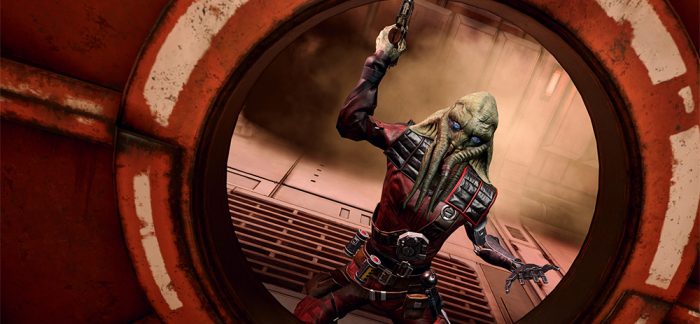
In Star Wars: Tales from the Galaxy's Edge, the player takes the role of a a droid repair technician who crash lands on Batuu after his employer's cargo transport gets raided by the alien pirate Tara Rashin (voiced by Debra Wilson) and her cronies from the Guavian Death Gang (the red suited mercenaries seen in Star Wars: The Force Awakens).
After crashing, you find yourself in a cantina owned by a boisterous
As you gain your bearings on Batuu, armed with the weapons you grabbed on the transport ship before it was hijacked, you'll encounter squads of these deadly pirates and must dispatch them with the trusty blaster (or two) at your side. The Oculus Quest 2 headset features two controllers, one for each hand, each with a control layout that basically mimics one half of a console controller, including a joystick for each hand but slightly fewer buttons than you'd expect. In the virtual world, these controllers are your hands, and you can use them to pick up various weapons for combat, or for ingredients to make a special drink that will get
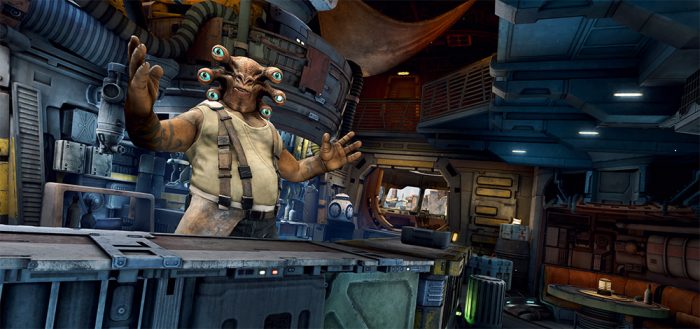
It takes a little while to get used to being completely surrounded by a video game environment within the Oculus headset. Your character can navigate within the virtual space by way of your actual footsteps as you walk around with the headset, but it's more likely that you'll use the joysticks to move your character around so you can stay within the same physical space without running into anything. This is where the features of the Oculus itself come in handy, because you can define the space in which you would like to remain, so if you happen to wander in your real physical space too much, you won't crash into your coffee table or couch.
The movement itself can be a little clunky, because while you can move your character's entire body forward or backward easily with the left joystick, the right joystick doesn't let you turn to change your perspective quite as smoothly. Granted, you have the entire 360-degree rotation of your body to turn more intuitively, but that's not always the most instinctual reaction when you have controllers in your hand. Instead, you'll find yourself turning with the right joystick in incremental degrees of 15, 30, or 45, a setting that can be changed within the game's menu. This can make the fast-paced action a little more challenging, but it does get easier after you've spent some time with the controls.
Also somewhat limiting in movement is the lack of jumping capabilities. You're given a hoverpack that can lift you a bit higher to get the upper hand on enemies or grab items/reach levels that are too high. But otherwise, the workaround is a "teleport" movement that basically allows you to point with the right controller where you'd like to move quickly. This is how you jump up and down cliff sides or on top of cargo containers. Though clumsy at first, it's another aspect that becomes second nature as time goes on.
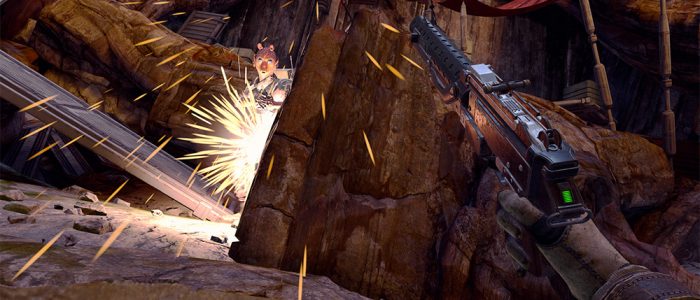
When you get used to these controls, taking on several Guavian Death Gang members at once isn't too difficult, even when there are deadly droids and nasty creatures joining them. This is especially true when you realize that you don't have to be frugal with your weapon resources, such as various training remote droids (just like the one Luke Skywalker uses to practice his lightsaber skills on the Millennium Falcon in A New Hope). There's one that will float around to protect you from enemies, another that has its own shield and will seek out bad guys to blast with lasers, and another that will merely smash into enemies and explode. And yes, they all make that cool swooshing sound as they zoom around you. It took awhile for me to realize that I needed to be using these remote training droids more, and once I started tossing several up into the air before heading into any altercation, it became much easier to progress through the various missions.
The shooting aspect of Tales from the Galaxy's Edge takes some practice. You're relying on your hands in a virtual world to be steady enough to aim carefully, but you also have to be savvy enough to know when to duck behind a rock or a shipping container to vent your blaster so it doesn't over heat or give yourself a bacta shot to heal from a blaster injury. You also have to be conscious of your blaster energy, because they lose their charge after being shot so many times. Thankfully, your enemies are always dropping their blasters after you gun them down, and you just keep swapping them out as you go along.
There's also some puzzle play as you make your way through Batuu. Every now and then you'll encounter containers that are like little electrical boxes. This is where a special item called the All-Kit comes into play, as it allows you to melt away welds with a fusion cutter, unscrew bolts with a torque wrench, or send an electric shock into a system. It's a small part of the game, but it's one of the things that feels the most tangible since it requires you to get up and close with your tool and it really makes you feel like a droid repair specialist. After you open these boxes, little puzzles inside can be solved using the All-Kit, and once completed, you'll be treated to a stock of new blasters, remote droids, credits, and even thermal detonators, which pack quite the punch. These items can also be found all around Batuu lying on cargo containers and sitting inside boxes.
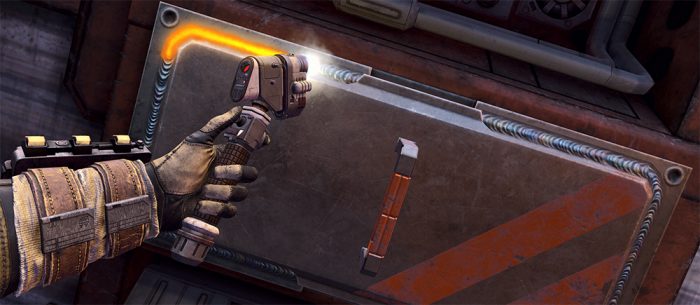
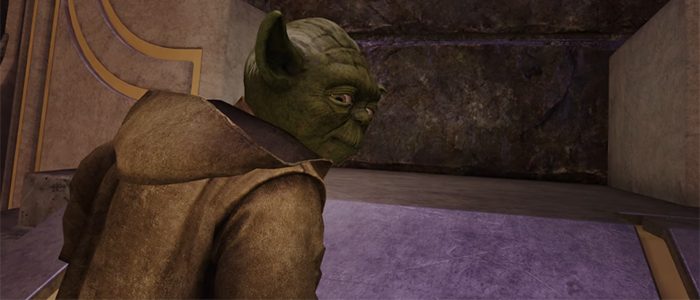
It's here that the real potential of Tales from the Galaxy's Edge becomes clear. While larger stories and adventures drive the game, these extra tales could provide a new way to experience the Star Wars universe in an intimate and captivating way. Since is a master storyteller and knows a lot about the universe around him, the possibilities are endless for future tales. Players might be able to experience iconic moments from the Star Wars saga from the perspective of a different character.
Star Wars: Tales from Galaxy's Edge has some shortcomings that are inherent to the limitations of virtual reality, but it also enhances traditional gameplay to make it a more rousing experience. Thanks to the Oculus, the fact that you can play this without needing a console or a computer is pretty impressive too. Virtual reality is only going to get better from here, and for now, games like Star Wars: Tales from the Galaxy's Edge will keep us busy and satisfied./Film Rating: 8 out of 10
